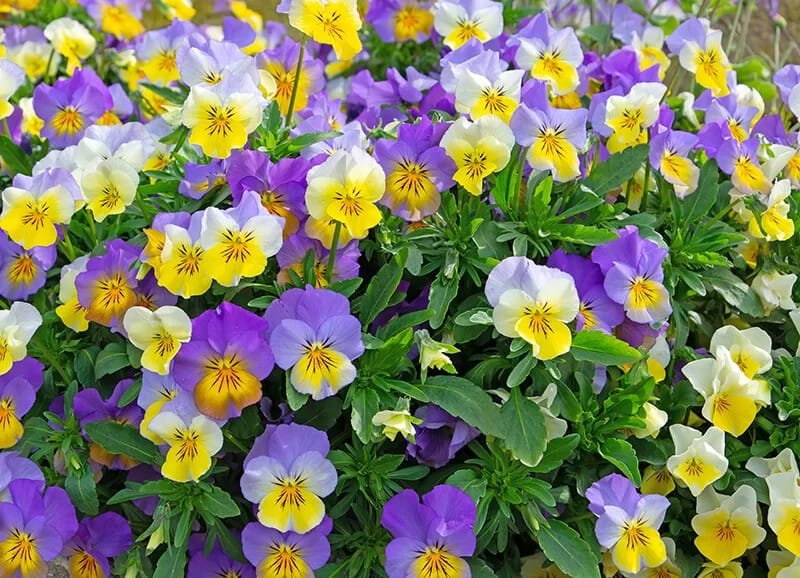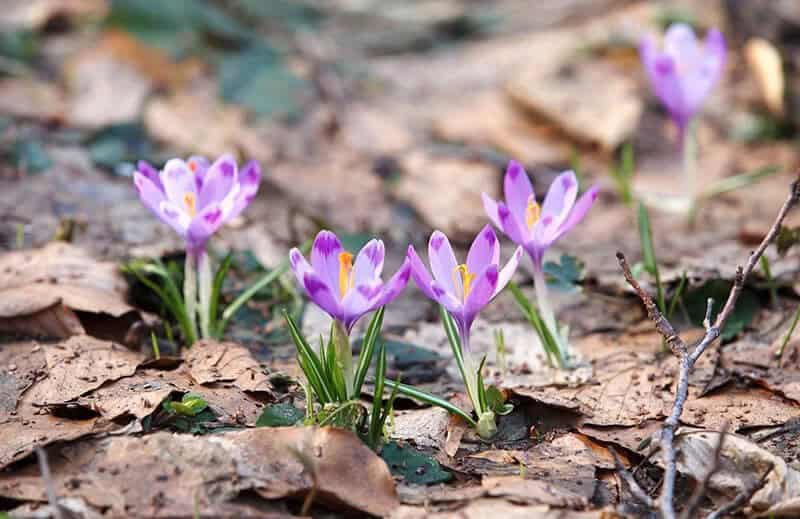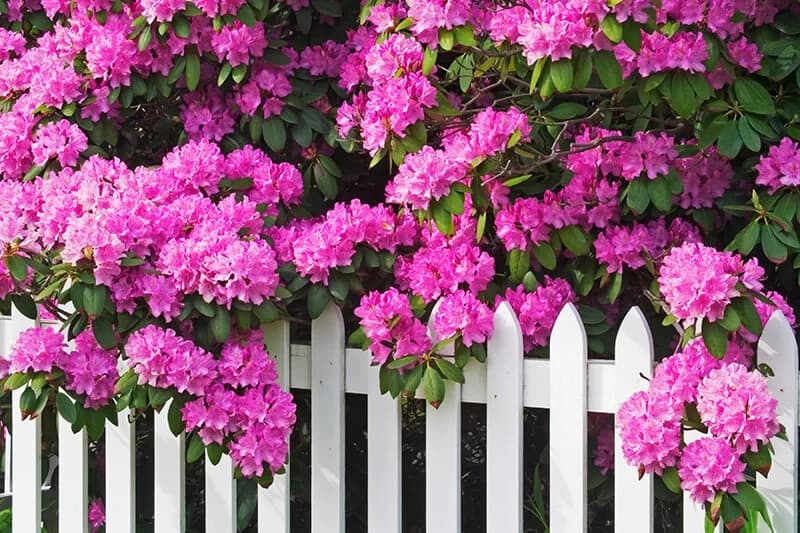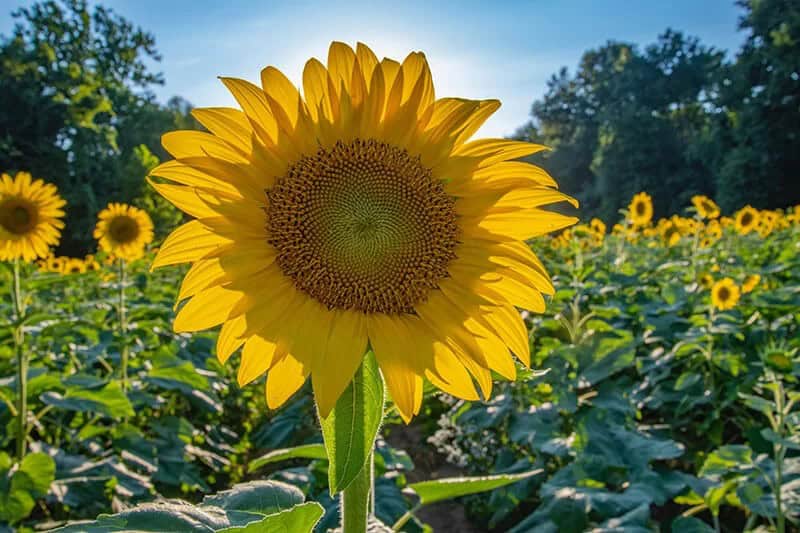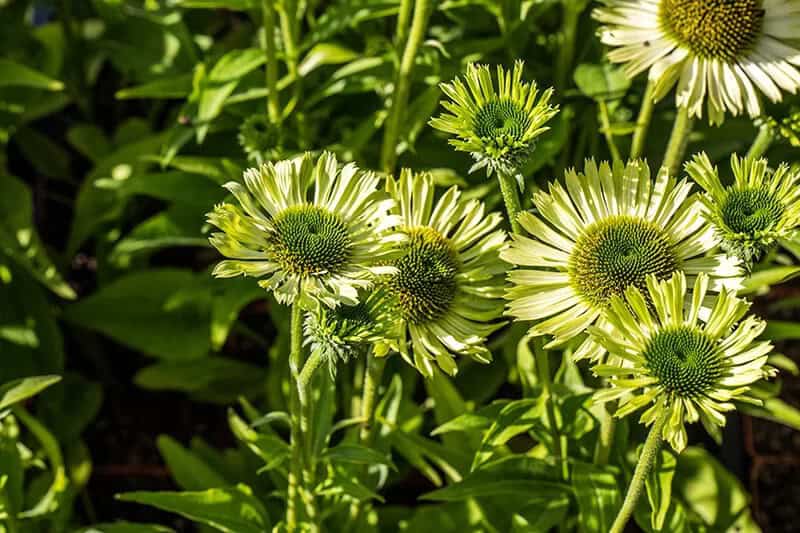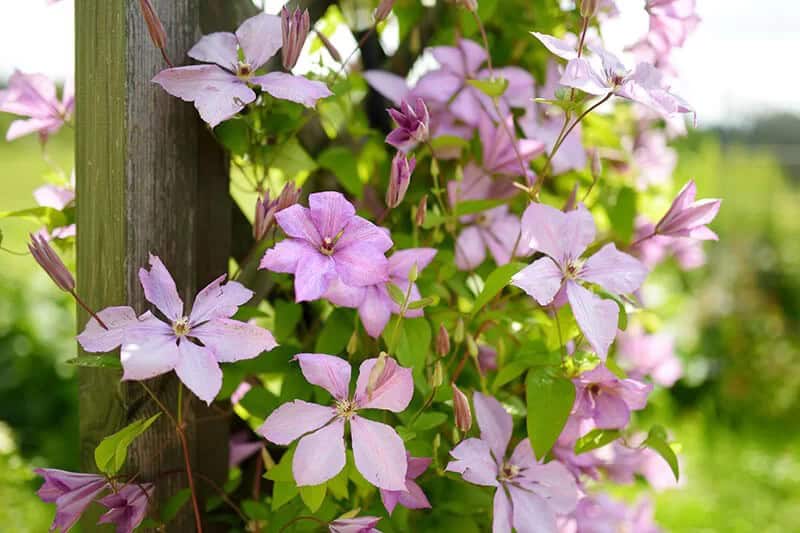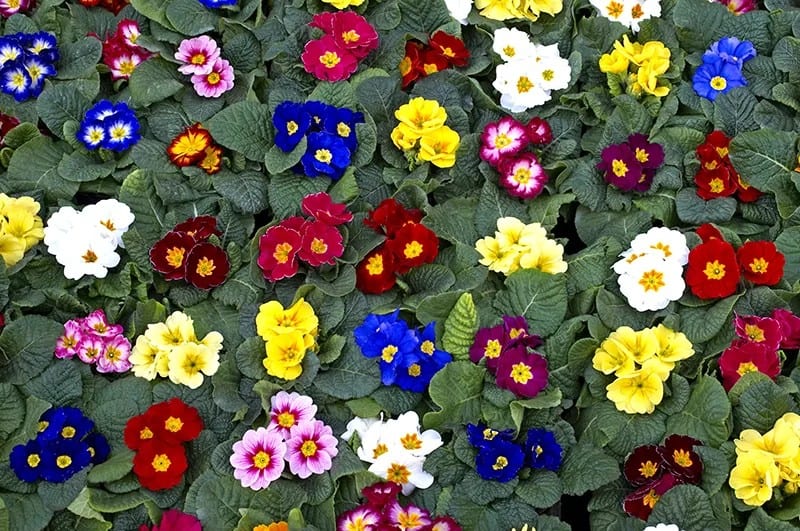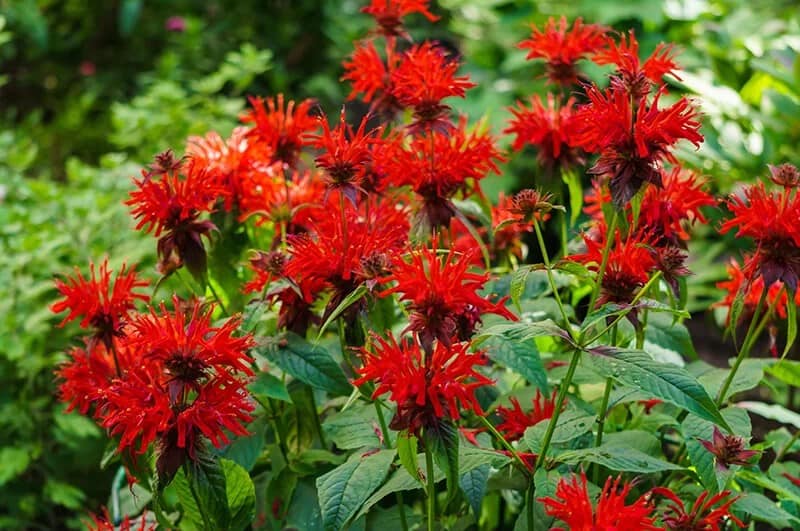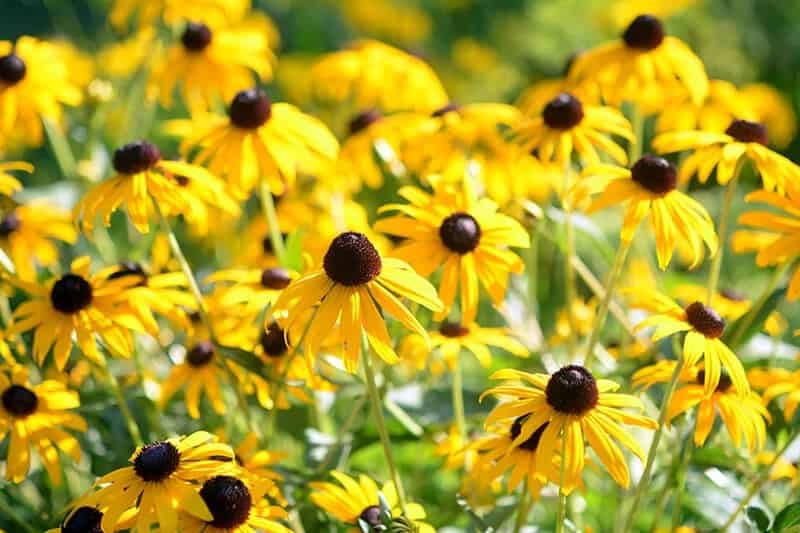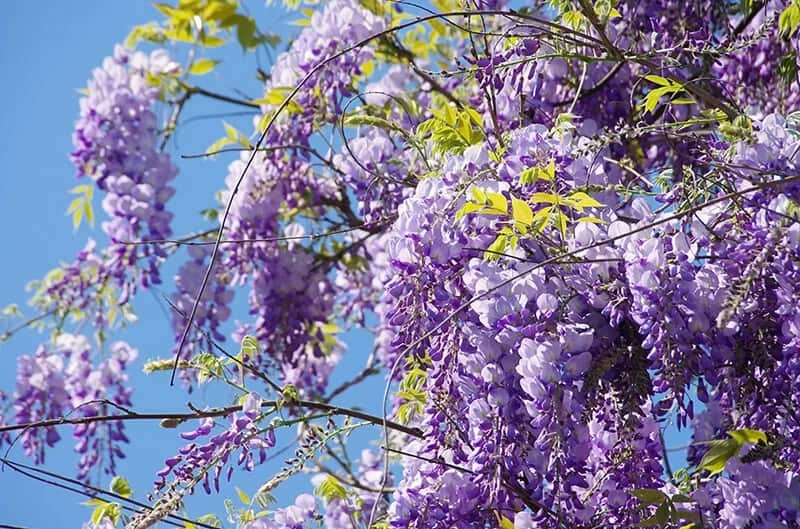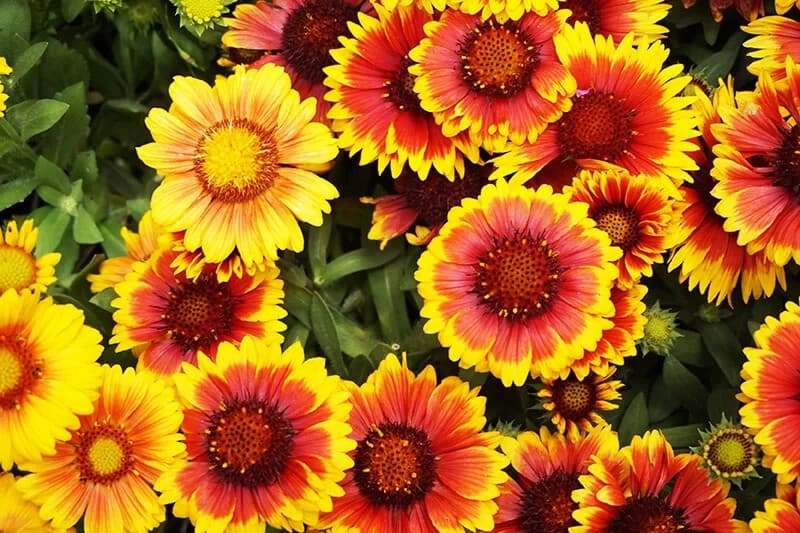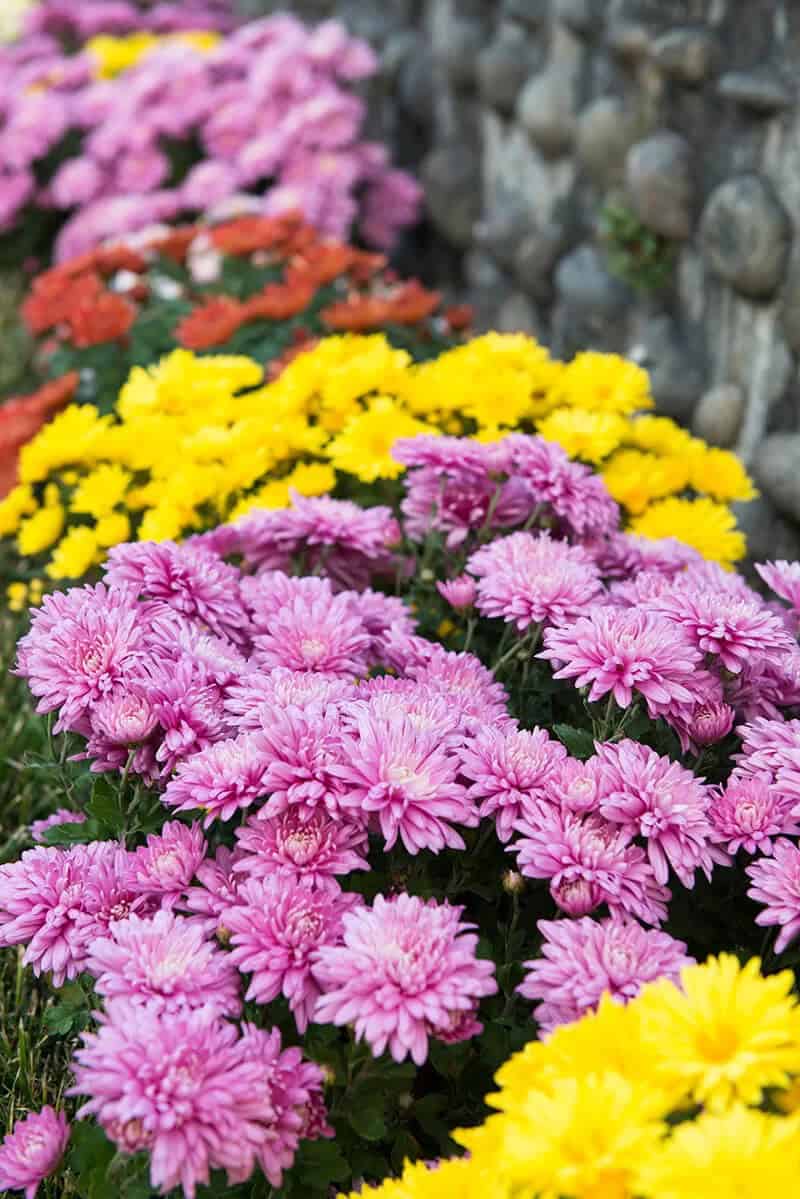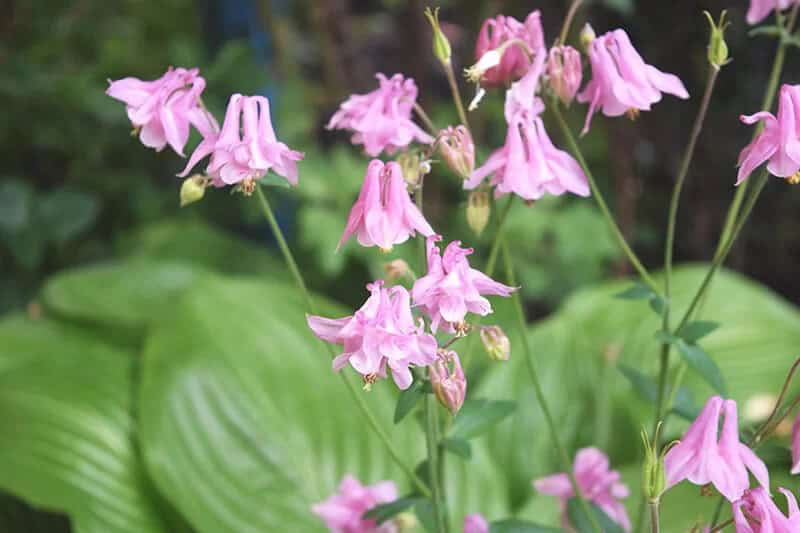Transforming your outdoor space into a vibrant oasis is just as much about creating an immersive experience as it is about cultivating beauty. Planting rainbow flowers allows for an unexpected pop of color to emerge with each passing day, inviting you to slow down and appreciate the simple joys of nature.
The Top 27 Most Intriguing Rainbow Flowers to Plant for a Rejuvenating Outdoor Space
To capture the essence of rainbows in your own unique way, start by reflecting on what this phenomenon means to you. Is it a kaleidoscope of colors or an arch comprising red, orange, yellow, green, blue, indigo, and violet? Don’t worry if you’re unsure – the beauty of rainbows lies in their subjectivity. As you explore different types of rainbow-inspired flowers, you’ll not only discover your botanical style but also uncover the perfect backdrop for various evergreen trees to thrive.
Petunia (Petunia)
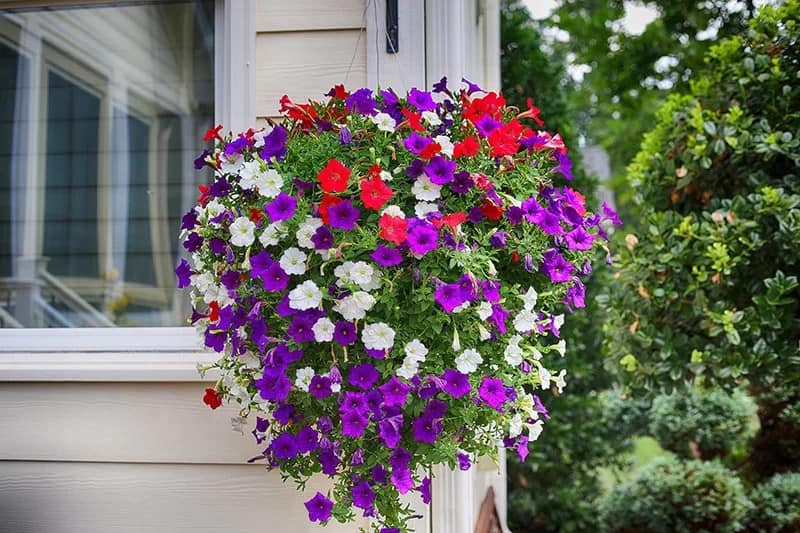
Petunias bring a touch of elegance to any outdoor space with their delicate, floppy petals and soft velvety foliage. As if that weren’t enough, these charming flowers come in a kaleidoscope of colors, excluding only the somber tones of brown or black. This versatility makes them an ideal choice for a rainbow-themed garden or any area where a pop of color is desired.
When grown under conditions of average soils with good drainage and full sun to part shade, petunias will reward you with vibrant blooms from May until frost, adding a soothing calm to your surroundings. As a symbol, they can evoke feelings of hopefulness, while also serving as a reminder of furious resentment when their soil or water needs are neglected. In zones 10 to 11, petunias thrive and require only medium watering.
Tulip (Tulipa)
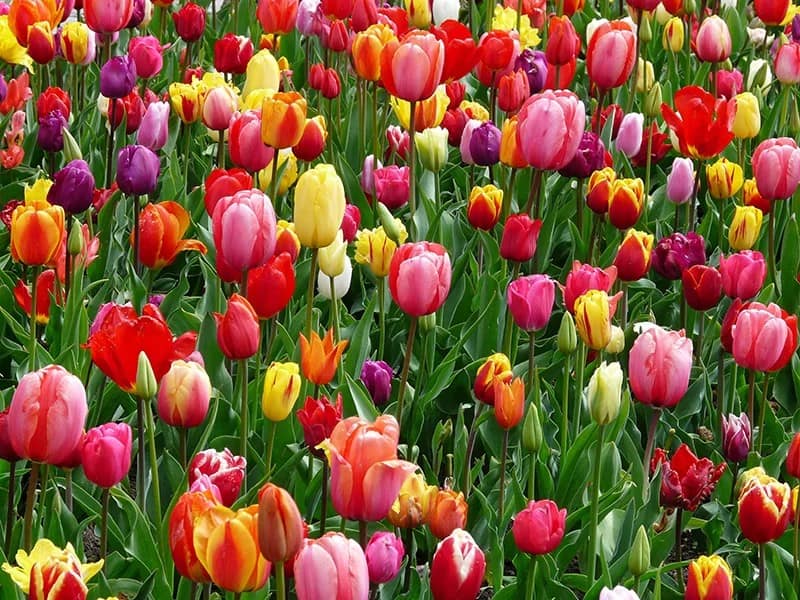
Tulips are often associated with perfect love, harmonious marriages, and charitable natures. These vibrant flowers thrive in medium water conditions and require fertile soil with good drainage to grow. They can be grown in zones 3-8 and prefer full sun. In the spring, tulips bloom from April to May, with many varieties available in a range of colors except true blue.
With each type of tulip holding its own unique symbolism, you can use different colored tulips to convey various messages.
To ensure your message is conveyed effectively, it’s best to plant tulip bulbs in groups. This allows for the flowers to be arranged in a way that spells out your desired message.
Daffodil (Narcissus ‘Southern Hospitality’)

Daffodils are renowned for their vibrant, low-maintenance blooms that usher in the arrival of spring. These sunshine-yellow flowers can be enjoyed in a single hue or showcased in a kaleidoscope of yellows and oranges, thanks to the double variety’s elegant ruffles. This stunning display is made possible by the plant’s medium water needs, ability to thrive in average soils with good drainage, and tolerance for full sun to part shade.
With growing zones ranging from 3 to 8, daffodils are a versatile choice for gardens of all sizes. Whether you’re looking to add a pop of color in March or April, these beautiful blooms are sure to delight. The double variety’s unique multicolored ruffles channel the warmth and energy of orange and yellow, making them a standout addition to any garden.
Bells of Ireland (Moluccella Laevis)
While green flowers may be less common than their vibrant counterparts, incorporating them into a rainbow-themed garden can be a unique and exciting challenge. One solution is to plant Bells of Ireland, which produce stunning green inflorescences throughout the summer and fall seasons. Not only will these blooms add a pop of color to your garden, but they’re also said to bring good luck, making them an attractive addition to any floral arrangement.
With their medium water needs, loose-textured fertile soil with good drainage, and ability to thrive in zones 2-11, Bells of Ireland are an accessible choice for gardeners of all levels. Plus, their full sun requirements make them a great fit for sunny spots in your yard. As you enjoy the beauty of these green blooms, remember that they typically bloom from July to September, making them a perfect addition to any summer or fall garden design.
Tufted Pansy (Viola Cornuta)
Tufted pansies bring a pop of color and whimsy to any garden space. The symbolism behind this vibrant flower is multifaceted, representing open-mindedness, remembrance, and even the joy of laughter. With their unique tufted appearance, these annuals offer endless opportunities for creativity in terms of color combinations and patterns. Whether you opt for a single-hued theme or a rainbow-inspired medley, the results are sure to delight.
Tufted pansies require medium watering needs and thrive in humus-type soils with good drainage. They can be grown in zones 6-11, tolerating full sun to part shade conditions. In terms of blooming season, expect a beautiful display of color from April to June.
False Indigo (Baptisia ‘Blueberry Sundae’)
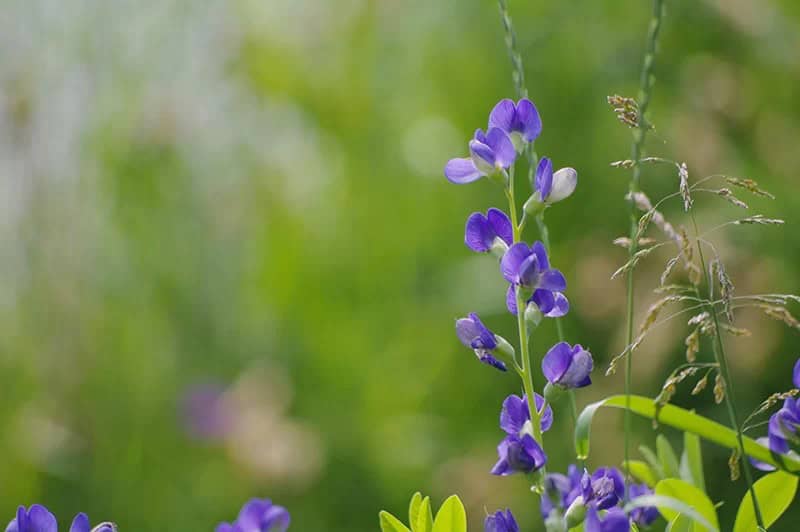
The captivating beauty of false indigo flowers, with their vibrant hues reminiscent of a rainbow’s promise, makes them an ideal choice for adding a splash of color to any garden. According to symbolism, these blooms convey messages of clarity, soothing qualities, and change – making them a fitting addition to any outdoor space. To thrive, false indigo requires dry to medium levels of moisture, average soil with good drainage, and full sun to part shade.
Its growing zones range from 4 to 9, allowing for versatility in its placement within your garden. In May and June, these flowers burst forth in a brilliant display of color, adding an extra layer of joy to any gardening experience. A compact variety like ‘Blueberry Sundae’ offers an even more intense indigo hue, making it perfect for smaller spaces.
Spring Crocus (Crocus vernus ‘Purpureus Grandiflorus’)
As winter’s chill begins to lift, the first signs of spring arrive with the vibrant emergence of crocuses. The symbolic significance of this variety lies in its representation of youthful happiness and childlike joy, encapsulated in its intense purple hue and velvety petals. A delightful contrast is provided by the cheerful yellow stamen.
Not only do these flowers bloom with a sense of exuberance, but they also thrive in a range of conditions, from full sun to part shade, and can tolerate gritty soils with good drainage or even clay soil. With a growing zone spanning 3 to 8, this spring crocus variety is sure to bring a splash of color to any garden, particularly during its April blooming season.
Rose (Rosa ‘Ausdir’ Tradescant)
Roses, as a timeless and versatile element in landscaping, should be a staple in every designer’s toolkit. This particular English shrub rose variety boasts rich, wine-red blooms, but the possibilities don’t stop there. With options ranging from red to nearly any other color imaginable, you can tailor your landscape to fit any theme or aesthetic.
Whether you’re aiming for a monochromatic look or a vibrant rainbow-inspired design, this variety of roses is sure to impress with its striking beauty and enduring appeal.
Azalea (Rhododendron ‘Gibraltar’)
The vibrant orange azalea is a stunning addition to any springtime garden. Its symbolic significance is deeply rooted in womanhood and fragility, making it a meaningful choice for those who value self-care. To thrive, this beauty requires medium water levels, acidic humus-rich soil with good drainage, and part shade. Growers in zones 5-8 will be delighted to know that their orange azalea will bloom from April to May, filling the air with its radiant colors.
Whether you’re seeking a pop of color or a symbol of empowerment, this unique flower is sure to bring joy to your outdoor space.
Sunflower (Helianthus Annuus)
Sunflowers are the towering giants of the garden landscape, reaching for the sky with their statuesque stalks and bright yellow blooms. These cheerful flowers are a natural protector against illness, symbolizing constant devotion and adoration. They thrive in dry to medium soil conditions, tolerating drought and poor soil quality. With average drainage, they can grow in a variety of environments, from zones 2 to 11.
When placed at the back of a garden bed, their vibrant petals shine like beacons, standing tall above other flowers. If yellow isn’t your color, there are sunflowers with red petals and purple centers that can add a pop of color to any space. In mid-summer, these beautiful blooms come into full glory from July to August, bringing joy and warmth to the garden.
Coneflower (Echinacea Purpurea ‘Green Jewel’)
The coneflower’s symbolism is deeply rooted in its benefits, representing good health and providing soothing relief from pain, as well as conveying a clear voice. Its harmonious relationship with water, soil, and light makes it an ideal addition to many landscapes.
In terms of its physical needs, the rainbow flower thrives in dry to medium conditions, exceling in average soils with good drainage. It’s also adaptable to different growing zones, ranging from 3 to 8.
One of the most striking features of this variety is its unique combination of cool green rays and dark green cones, creating a stunning visual contrast. As a native wildflower, coneflowers are naturally adept at adapting to various garden conditions, making them an excellent choice for adding a pop of green to your landscape.
Clematis (Clematis ‘The President’)
The clever, vibrant, and resourceful symbolism of the clematis flower is perfectly reflected in its stunning indigo blooms. With medium water needs, this flowering vine thrives in fertile soil with good drainage. Its hardiness allows it to flourish in USDA growing zones 4 to 8. Providing full sun to part shade, the clematis cultivar blooms from May to September, making it a reliable and striking addition to any garden.
This award-winning variety is sure to carpet your landscape in shades of blue and purple, adding an air of sophistication to your outdoor space.
Polyanthus Primrose (Primula Veris x Primula Vulgaris)
The vibrant and adaptable Polyanthus Primrose is a delightful addition to any cool climate garden. Its unique characteristic is its ability to bloom in a kaleidoscope of colors – excluding green – making it an ideal choice for those looking to bring a splash of rainbow hues into their outdoor space. With medium water needs, slightly acidic fertile soil that drains well, and a growing zone range of 5-7, this charming flower thrives in partial shade to full shade.
As the seasons shift towards April-May, Polyanthus Primrose bursts forth with its springtime bloom, generously filling shady areas with an explosion of color.
Bearded Iris (Iris Germanica)
Named after the ancient Greek goddess of the rainbow, Bearded Irises are a staple in any rainbow-themed garden. Their ruffled, velvety petals flow like a colorful waterfall, available in a variety of hues to fit your unique vision. Adding an ostentatious border of these striking flowers can bring a touch of drama to your garden’s design. This charming bloom requires medium watering, fertile humus-rich soil with good drainage, and full sun exposure, making it suitable for growing zones 3 to 10.
May is the perfect time to witness their vibrant display.
Bee Balm (Monarda ‘Gardenview Scarlet’)
The beauty of bee balm lies not only in its vibrant scarlet blooms, but also in its ability to attract a kaleidoscope of pollinators. This striking herbaceous perennial is said to possess symbolic properties that promote good digestion, soothe away pain, and banish unpleasantness. To thrive, bee balm requires medium to wet soil conditions and average soils that retain moisture. Gardeners in USDA hardiness zones 4 through 9 can enjoy the benefits of this lovely plant.
Bee balm also needs full sun to partial shade, with the best blooming period typically occurring between June and August. Interestingly, planting multiple groupings of bee balm can significantly increase the likelihood of attracting a rainbow of hummingbirds to your garden.
French Marigold (Tagetes Patula)
The French marigold is a vibrant addition to any garden or indoor space, boasting a kaleidoscope of colors in shades of yellow, orange, and burgundy. This low-maintenance beauty thrives with minimal care, making it an ideal choice for busy gardeners. With its impressive flowering season, which can last from June until the first frost, you’ll be treated to a constant display of ruffled, velvety blooms.
To encourage the French marigold’s natural habit of producing an abundance of flowers, simply remove spent blooms by deadheading. The result is a stunning, continuous show of color that requires little more than good drainage and average soil conditions.
Black-Eyed Susan (Rudbeckia ‘American Gold Rush’)
The iconic Black-eyeed Susan flower is renowned for its vibrant yellow hue, which can be effortlessly incorporated into any garden. As a native species, it has adapted to thrive in a diverse range of environments, producing an abundance of color throughout the blooming season. While its solitary shade of yellow may not offer the same visual diversity as other rainbow flowers, it still plays a crucial role in attracting birds and butterflies to your outdoor space.
With their ability to bloom from July to September, Black-eyeed Susans are an excellent choice for any gardener seeking to add a pop of brightness to their landscape.
Prickly-Pear (Opuntia Humifusa)
Prickly-pear cacti bring a breath of fresh air to any garden with their symbolism of humor and endurance. This drought-tolerant plant thrives in sandy soils with excellent drainage, making it perfect for dry climates. Found growing zones 4 to 9, the prickly-pear cactus requires full sun exposure to bloom from June to July. The vibrant yellow flowers are a beautiful addition to any garden, complemented by the unique green hue of its pads when surrounded by lush foliage.
In summer, the ruffled golden petals add a touch of warmth and optimism to your outdoor space.
Blue Lotus (Nymphaea Caerulea)
The Blue Lotus is a captivating addition to any water feature, boasting delicate blue petals, yellow stamen, and vibrant green lilypads. Its preference for aquatic conditions makes it an ideal choice for ponds and water gardens, where its bright colors can shine through the wet environment. To experience the sweet fragrance of these flowers, consider planting them near walkways or seating areas.
With proper care, this spiritual symbol of awakening, beauty, and life can thrive in growing zones 10 to 12, requiring full sun and an aquatic soil setup.
Hydrangea (Hydrangea Macrophylla)
The humble hydrangea plant boasts a unique array of symbolic meanings, including self-satisfaction and prideful beauty. Its stunning blooms, which can range from true blue to lilac purple and vibrant pink, are further enhanced by its lush green foliage. When it comes to growing conditions, the hydrangea thrives in medium water levels, fertile soil with good drainage, and a specific soil chemistry that affects flower color.
This hardy plant is tolerant of part shade and can be grown in USDA zones 6 through 9, making it an ideal choice for many gardeners. In terms of blooming season, the hydrangea typically flowers from July to August, offering a pop of color during the warmest months of the year. By combining this striking plant with other blooms featuring red, orange, and yellow hues, gardeners can create a breathtaking landscape that showcases all the colors of the rainbow.
American Wisteria (Wisteria Frutescens)
The American Wisteria boasts a unique charm, with its hospitable welcome evoking summertime poetry and youthful exuberance. When it comes to its water needs, this plant thrives in medium-moist environments. The soil should be slightly acidic and fertile, with good drainage to prevent any root rot. As for growing zones, the American Wisteria is well-suited for zones 5 through 9. In terms of light requirements, full sun is ideal, allowing the plant to fully express its vibrant colors.
If you’re eager to enjoy a lilac-blue waterfall of flowers without the concerns that come with invasive Asian wisteria, this variety is an excellent choice. One thing to keep in mind is that American Wisteria does require pruning, making it best suited for gardeners who appreciate the therapeutic benefits of trimming and shaping their plants.
Blanket Flower (Gaillardia Aristata ‘Bijou’)
The allure of the blanket flower lies in its promise of a vibrant, long-lasting display with minimal watering demands. Its rich reds and opulent golds create a kaleidoscope of color that can be enjoyed from May to September. A compact variety, this shorter bloom is perfect for adding depth and dimension to borders or serving as a stunning front edging. It thrives in average soils with good drainage and tolerates drought conditions, making it an ideal choice for busy gardeners.
With its ability to tolerate full sun and grow in zones 3-8, the blanket flower is a low-maintenance yet high-reward addition to any garden design.
Chrysanthemum (Chrysanthemum Morifolium)
The late-blooming chrysanthemum is a stunning addition to any garden, particularly during the fading colors of late fall. This vibrant flower has the power to revitalize and add a pop of color to your outdoor space. Not only do they come in a range of hues, but they can also be used to create visually striking arrangements. Imagine a bed of mums arranged in colorful stripes or simple shapes, adding depth and dimension to your garden design.
With their symbolism of long life, joyful friendship, and optimistic eternity, these flowers are sure to bring a smile to anyone’s face. To grow this beauty, you’ll need medium watering, fertile soil with good drainage, full sun, and a growing zone between 5 and 9. September until frost is the blooming season for these lovely mums.
Hyacinth (Hyacinthus Orientalis Etouffee)
Add a pop of color to your spring garden with this stunning variety of hyacinth. Characterized by tight clusters of highly fragrant pastel flowers, it’s sure to bring a touch of whimsy and wonder to your outdoor space. With blooms in a range of colors including blue, purple, and pink, you can create a rainbow effect by planting them alongside other spring-blooming perennials like tulips and daffodils.
This low-maintenance beauty requires medium water needs, average soils with good drainage, and full sun to part shade. It thrives in zones 4 to 8, making it an ideal choice for gardeners of all levels. As the flowers bloom from March to April, you’ll be treated to a sweet scent that’s sure to transport you to a state of peace and serenity.
Columbine (Aquilegia Canadensis)
Columbine, with its intricate origami-like shape and vibrant color palette, is sure to captivate gardeners with its perpetual display of beauty. This native American perennial boasts striking reddish-pink and yellow petals that will leave you in awe. But the excitement doesn’t stop there – the flowers also attract jewel-toned hummingbirds, making it a treat for the senses.
With medium water needs, average soils with good drainage, and a growing zone range of 3 to 8, columbine is an excellent choice for those looking to add some visual interest and wildlife-friendly charm to their outdoor spaces.
Pretty-By-Night (Mirabilis Jalapa)
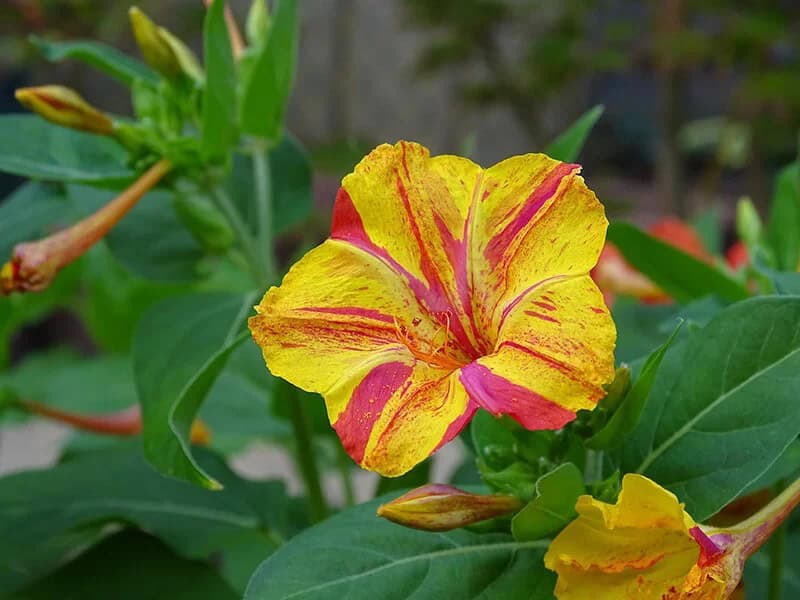
The enchanting [insert flower name] boasts an array of symbolic meanings, including fiery passion and shyness. This captivating bloom thrives in medium-watered environments with well-draining soils, making it ideal for gardeners in USDA Hardiness Zones 9 to 11. As the sun sets, these flowers open in late afternoon, releasing a burst of color that persists throughout the night before closing at dawn.
When used as a hedge, the [insert flower name] adds a touch of Victorian elegance to any landscape. Its unique patterns are not only visually stunning but also serve as a conversation starter. Whether showcased as a solo specimen or part of a larger design, this extraordinary bloom is sure to captivate and inspire.
Verveine (Lantana Camara)
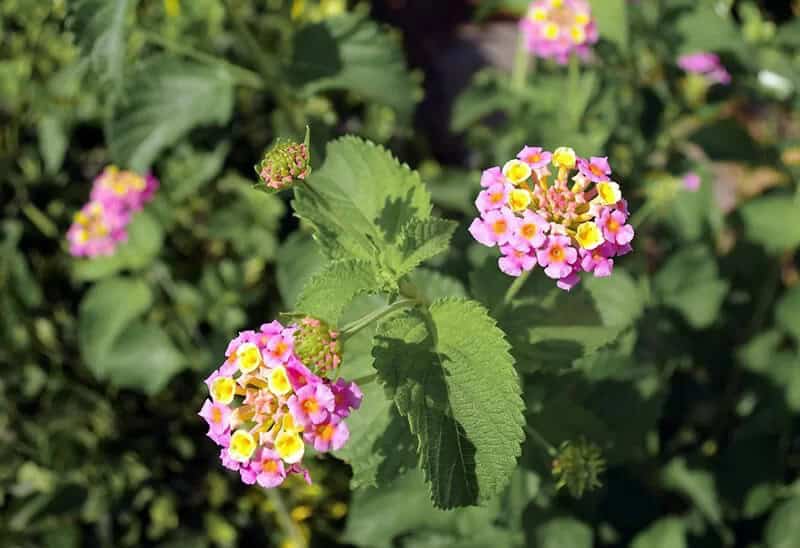
Verveine, a standout among rainbow flowers, boasts an extraordinary trait – each floral cluster is a miniature kaleidoscope of colors. The vibrant blooms combine shades of red, orange, yellow, purple, and white, making every bunch a unique surprise. This enchanting flower thrives in average soils with good drainage and tolerates drought to some extent. It requires medium watering.
When grown in zones 10-11, verveine revels in full sun, producing a spectacular display from July until the first frost. Plant it alongside blue-flowering plants with green foliage, and you’ll be treated to an array of colors reminiscent of the rainbow. This rare gem promises good fortune, vigorous strength, and makes wishes come true, as symbolized by its 🔮 emblem.
27 Unforgettable Rainbow Flowers to Plant in a Garden that Craves More Color
As you step into a vibrant garden featuring an array of rainbow-hued blooms, the possibilities seem endless. The beauty of creating a rainbow-themed garden lies in its versatility – there’s no one-size-fits-all approach. One way to achieve the desired effect is by strategically interplanting flowers that showcase a single, bold color, resulting in a harmonious rainbow display. Alternatively, you can opt for multicolored blooms, allowing each flower to shine in its own unique hue.
Some gardeners may prefer a combination of both approaches, blending single-colored and multicolored flowers to create an explosion of color. When selecting the perfect flowers for your rainbow garden, consider whether you want to emphasize soft, gentle pastel hues or bold, energizing jewel tones.

